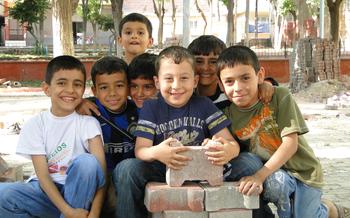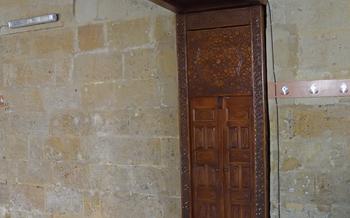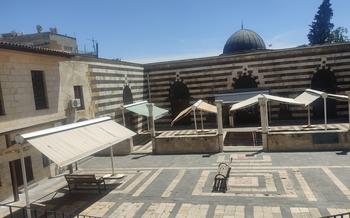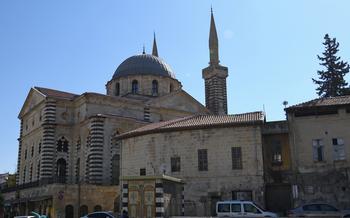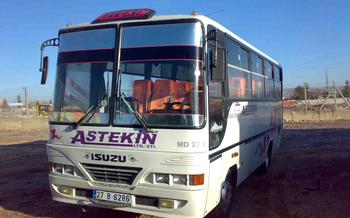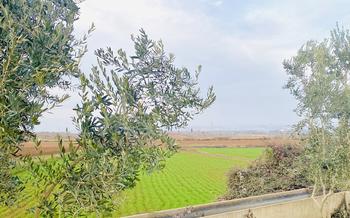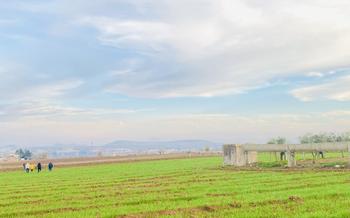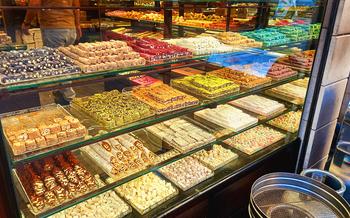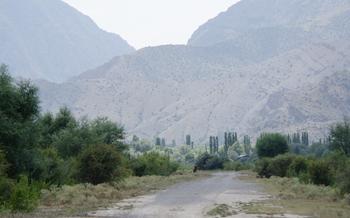
The Hasan Suzer Ethnography Museum
- History of the Hasan Suzer Ethnography Museum
- Location and Accessibility:
- Museum Collections
- Traditional Gaziantep House
- Copperware and Metalwork: Shaping Tradition in Every Hammered Piece
- Textiles and Embroidery
- Pottery and Ceramics
- Furniture and Woodwork
- Blacksmithing and Metalworking
- Music and Instruments
- Traditional Costumes
- Cultural Events and Demonstrations
- Educational Programs
- Museum Facilities
- Insider Tips for a Memorable Visit:
History of the Hasan Suzer Ethnography Museum
The Hasan Suzer Ethnography Museum, a treasure-trove of Gaziantep's cultural heritage, owes its existence to the passion and dedication of its founder, Hasan Suzer. A native of Gaziantep with a profound love for his city's history and traditions, Suzer embarked on a mission to preserve and showcase the rich cultural legacy of his homeland. Driven by this vision, he established the museum in 1974, transforming his family home into a repository of Gaziantep's tangible and intangible heritage.
The museum is not just a collection of artifacts; it is a testament to Suzer's unwavering commitment to safeguarding the cultural identity of Gaziantep. His tireless efforts to acquire and document artifacts, coupled with his meticulous attention to detail, have resulted in a museum that is both informative and inspiring, attracting visitors from far and wide who seek a deeper understanding of Gaziantep's vibrant cultural tapestry.
Location and Accessibility:
The Hasan Suzer Ethnography Museum is situated in the heart of Gaziantep, within the historic Gümrük Han, an ancient caravanserai that served as a trading hub along the Silk Road. To reach the museum, visitors can take a short walk from the city center or utilize public transportation, with several bus lines stopping nearby. For those arriving by car, ample parking is available in the vicinity.
Museum Collections
The Hasan Suzer Ethnography Museum houses a diverse collection of artifacts that provide a glimpse into the rich cultural heritage of Gaziantep. Highlights include traditional costumes, copperware, textiles, pottery, furniture, and musical instruments. Each exhibit tells a story about the daily life, traditions, and craftsmanship of the region.
Copperware and Metalwork
Gaziantep is renowned for its exquisite copperware, and the museum showcases a collection of intricately crafted copper items. From kitchen utensils to decorative pieces, these artifacts demonstrate the skill and artistry of local metalworkers. Traditional techniques and motifs are used to create unique and visually stunning pieces that reflect the region's cultural identity.
Textiles and Embroidery
Gaziantep's textile heritage is equally impressive, with a rich tradition of embroidery and weaving. The museum displays a variety of textiles, including intricately embroidered garments, carpets, and household items. Techniques like iğne oyası (needle lace) are showcased, highlighting the painstaking craftsmanship and creativity of local artisans. These textiles not only serve a practical purpose but also hold cultural significance, representing the region's artistic heritage and storytelling traditions.
Pottery and Ceramics
Gaziantep's potters have a long history of creating beautiful and functional ceramics. The museum's collection includes a range of pottery items, from tableware to decorative pieces, showcasing traditional techniques and decorative styles. Visitors can admire the intricate designs and vibrant colors that characterize Gaziantep's pottery, reflecting the region's artistic sensibilities and craftsmanship.
Traditional Gaziantep House
Within the museum complex, visitors can explore a meticulously restored traditional Gaziantep house, offering a glimpse into the architectural heritage and domestic life of the region. The house showcases the unique features of Gaziantep's traditional architecture, including its distinctive arched doorways, intricate stone carvings, and spacious courtyards.
Inside the house, each room serves a specific function, providing insights into the daily lives of Gaziantep's residents. The main living area, known as the "sofa," is adorned with colorful kilims, intricately carved wooden furniture, and a central hearth for warmth and cooking. The kitchen is equipped with traditional tools and utensils, reflecting the region's culinary traditions.
The house also features separate sleeping quarters for men and women, as well as a guest room for hosting visitors. The guest room is often decorated with the finest textiles and furnishings, reflecting the importance of hospitality in Gaziantep culture.
Through this immersive experience, visitors gain a deeper understanding of the region's cultural heritage and the way of life that has shaped Gaziantep's identity.
Copperware and Metalwork: Shaping Tradition in Every Hammered Piece
Gaziantep has long been renowned for its exquisite copperware and metalwork, a testament to the city's rich craftsmanship. The Hasan Suzer Ethnography Museum proudly showcases this artistic tradition, housing a collection of copperware items that range from utilitarian kitchen utensils to intricately designed decorative pieces.
Visitors to the museum can marvel at the skill and precision of Gaziantep's coppersmiths. Traditional techniques, passed down through generations, are meticulously employed to craft each piece. From hammering and shaping the copper sheets to applying intricate engravings and embossing, the process is a true display of artistry.
The copperware collection at the Hasan Suzer Ethnography Museum encompasses a wide variety of forms and functions. From gleaming pots and pans that once graced traditional Gaziantep kitchens to decorative trays, vases, and lamps, each piece tells a story of local craftsmanship and cultural heritage.
One of the highlights of the collection is a magnificent copper basin, meticulously engraved with intricate Islamic motifs. This basin, a testament to the skill of Gaziantep's artisans, would have been used for special occasions, such as weddings or religious ceremonies.
Another notable piece is a set of intricately designed coffee pots, each adorned with unique patterns and embellishments. These pots, once used to brew and serve the aromatic Turkish coffee, offer a glimpse into the daily lives and traditions of the region.
The copperware and metalwork collection at the Hasan Suzer Ethnography Museum is not just a display of beautiful objects; it is a celebration of Gaziantep's rich cultural heritage and the artistry of its craftsmen. Through these exquisite pieces, visitors can gain a deeper appreciation for the skill, creativity, and dedication that define Gaziantep's metalworking traditions.
Textiles and Embroidery
Gaziantep boasts a rich textile heritage and embroidery traditions that are showcased in the Hasan Suzer Ethnography Museum. The museum houses a diverse collection of textiles, including finely woven carpets, intricate embroideries, and traditional garments. Visitors can admire the craftsmanship and artistry of local artisans as they explore the various textile exhibits.
One of the highlights of the collection is the iğne oyası (needle lace) technique, which is a traditional form of embroidery that involves using a needle and thread to create delicate lace patterns. Visitors can witness the intricate process of needle lace making and appreciate the skill and patience required to create these intricate works of art.
The museum also displays a variety of other embroidery techniques, such as cross-stitch, satin stitch, and appliqué. These techniques are used to create a wide range of textiles, including tablecloths, cushion covers, and clothing. Each textile tells a story about the local culture and traditions, and visitors can learn about the significance of textiles in daily life and special occasions in Gaziantep.
Pottery and Ceramics
Gaziantep boasts a rich pottery tradition that dates back to ancient times. The city's potters are renowned for their exquisite craftsmanship and unique decorative styles. At the Hasan Suzer Ethnography Museum, visitors can marvel at an impressive collection of pottery and ceramics that showcases the diversity and artistry of this ancient craft.
The museum houses a wide range of pottery items, from utilitarian tableware to decorative vases and intricate tiles. Each piece is a testament to the skill and creativity of the local potters. Traditional pottery techniques, such as hand-building and wheel-throwing, are still used to create these beautiful objects.
Among the highlights of the collection are the distinctive "Gaziantep tiles." These tiles are characterized by their vibrant colors, intricate geometric patterns, and raised relief designs. They were traditionally used to decorate the interiors and exteriors of buildings, adding a touch of elegance and artistry to the urban landscape.
The museum also displays a variety of ceramic items, including plates, bowls, jugs, and pitchers. These ceramics are often adorned with intricate hand-painted designs that draw inspiration from nature, local culture, and Islamic art. The vibrant colors and intricate patterns of these ceramics make them highly sought-after by collectors and enthusiasts.
Exploring the pottery and ceramics collection at the Hasan Suzer Ethnography Museum is a journey through the rich artistic heritage of Gaziantep. Visitors can admire the skill and creativity of the local potters, learn about the traditional techniques used in pottery making, and gain a deeper appreciation for the cultural significance of this ancient craft.
Furniture and Woodwork
Gaziantep boasts a rich tradition of furniture making and woodwork that has been passed down through generations of skilled artisans. The Hasan Suzer Ethnography Museum showcases a collection of traditional Gaziantep furniture, providing visitors with a glimpse into the craftsmanship and artistry of the region.
The furniture on display exhibits a blend of functionality and aesthetic appeal. Intricate carvings, geometric designs, and mother-of-pearl inlays adorn wooden pieces, reflecting the influence of Ottoman and Seljuk styles. Visitors can admire intricately crafted cabinets, tables, chairs, and chests, each piece telling a story of the region's cultural heritage.
One of the highlights of the collection is a traditional Gaziantep sofa known as a "divan." These sofas are characterized by their low seating and intricate woodwork, often featuring elaborately carved legs and backrests. They were traditionally placed in the main reception room of a house, serving as a comfortable seating area for guests.
The museum also displays a variety of wooden objects, including decorative boxes, trays, and bowls. These items showcase the skills of local woodworkers in creating both functional and visually appealing pieces. The use of different types of wood, such as walnut, oak, and cedar, adds to the richness and diversity of the collection.
Through its collection of furniture and woodwork, the Hasan Suzer Ethnography Museum offers visitors a unique opportunity to appreciate the artistry and craftsmanship that has shaped Gaziantep's cultural identity.
Blacksmithing and Metalworking
Blacksmithing holds a significant place in Gaziantep's cultural heritage, dating back to ancient times when the city served as a hub for trade and craftsmanship. The Hasan Suzer Ethnography Museum showcases this rich tradition through a captivating display of blacksmithing tools and products. Visitors can marvel at the intricate craftsmanship and decorative elements that adorn knives, tools, and other metal objects. The museum also provides insights into the traditional techniques employed by local blacksmiths, demonstrating the skill and precision required in this ancient craft.
Music and Instruments
Gaziantep boasts a rich musical tradition, and the Hasan Suzer Ethnography Museum showcases a collection of traditional instruments that have played an integral role in local celebrations and cultural events. Visitors can marvel at the intricate craftsmanship of these instruments, which range from the bağlama (saz), a stringed instrument similar to the lute, to the darbuka (goblet drum) and the def (frame drum). The museum also provides insights into the role of music in storytelling, religious ceremonies, and daily life in Gaziantep, highlighting the significance of music as a means of cultural expression and community bonding.
Traditional Costumes
The Hasan Suzer Ethnography Museum showcases an impressive collection of traditional costumes worn by the people of Gaziantep, offering a glimpse into the region's rich cultural heritage. These costumes, meticulously preserved and displayed, reflect the unique identity and craftsmanship of the local community.
Visitors can marvel at the vibrant colors, intricate embroidery, and distinctive designs that adorn these garments. Each costume tells a story, representing different social classes, religious groups, and special occasions. From elaborate wedding dresses to everyday attire, the collection provides a comprehensive overview of Gaziantep's traditional fashion.
The cultural significance of these costumes extends beyond their aesthetic appeal. They embody the region's history, traditions, and social customs. Visitors can learn about the symbolism behind certain colors and patterns, as well as the techniques used to create these beautiful garments.
The evolution of traditional costumes over time is also explored through the museum's collection. Visitors can trace the changing styles and influences that have shaped Gaziantep's fashion landscape, from the Ottoman era to the present day.
By showcasing these traditional costumes, the Hasan Suzer Ethnography Museum celebrates the diverse cultural heritage of Gaziantep and provides a valuable resource for researchers and fashion enthusiasts alike.
Cultural Events and Demonstrations
The Hasan Suzer Ethnography Museum is not just a static display of artifacts; it also brings Gaziantep's rich cultural heritage to life through engaging events and demonstrations. Visitors can immerse themselves in the local culture by participating in workshops, demonstrations, and performances that showcase traditional crafts, music, and dance.
The museum regularly hosts workshops on traditional crafts such as copperware, pottery, and embroidery. These workshops provide a hands-on opportunity for visitors to learn the techniques and create their own unique souvenirs. Visitors can also witness live demonstrations by skilled artisans, who showcase their mastery of traditional crafts and answer questions about their work.
For those interested in music and dance, the museum organizes performances by local musicians and dancers. These performances feature traditional Gaziantep music played on instruments like the bağlama (saz) and the darbuka (goblet drum), accompanied by vibrant and energetic folk dances.
By attending these cultural events and demonstrations, visitors gain a deeper understanding of Gaziantep's living cultural heritage and the passion of its people for preserving their traditions. The museum's calendar highlights upcoming events, allowing visitors to plan their visit accordingly.
Educational Programs
The Hasan Suzer Ethnography Museum offers a variety of educational programs aimed at enriching the learning experience for visitors of all ages. These programs are designed to promote cultural understanding, preserve traditional knowledge, and foster a sense of appreciation for Gaziantep's rich heritage.
The museum's educational team provides guided tours for school groups, tailored to different age levels and curriculum requirements. These tours offer students an immersive experience, allowing them to engage with the exhibits and learn about the history and significance of the artifacts.
Families with children can participate in family-friendly workshops, designed to encourage creativity and hands-on learning. These workshops introduce children to traditional crafts, games, and customs of Gaziantep, fostering a sense of cultural connection and appreciation.
The museum also offers educational programs for researchers and enthusiasts seeking to delve deeper into specific aspects of Gaziantep's cultural heritage. Lectures, seminars, and workshops are organized on topics such as traditional architecture, gastronomy, music, and crafts, providing a platform for knowledge sharing and exchange.
By offering these educational programs, the Hasan Suzer Ethnography Museum plays a vital role in preserving and promoting Gaziantep's cultural legacy while fostering a sense of pride and appreciation among the local community and visitors alike.
Museum Facilities
The Hasan Suzer Ethnography Museum provides visitors with a range of amenities to enhance their experience. A well-stocked gift shop offers an array of souvenirs and handicrafts, allowing visitors to take home a piece of Gaziantep's rich cultural heritage. A cozy cafeteria provides a welcoming space for visitors to relax and enjoy refreshments, while a specialized library houses a wealth of resources for researchers and those seeking to delve deeper into the region's cultural history.
Furthermore, the museum is committed to accessibility and inclusivity. Wheelchair ramps and elevators ensure that visitors with disabilities can navigate the museum's spaces with ease. Clear signage and multilingual guides cater to visitors from diverse linguistic backgrounds, ensuring that everyone can fully appreciate the museum's exhibits and learn about Gaziantep's cultural heritage.
Insider Tips for a Memorable Visit:
For an optimal experience at the Hasan Suzer Ethnography Museum, plan your visit for a weekday morning to avoid the weekend crowds. This will allow you to leisurely explore the exhibits and engage with the museum staff without distractions.
While in the area, take advantage of the opportunity to savor the local cuisine at one of the nearby restaurants. For an authentic taste of Gaziantep's culinary heritage, try the traditional "beyran" soup, a hearty and flavorful dish made with lamb, rice, and spices.
Remember to bring your camera to capture the intricate details and vibrant colors of the museum's artifacts. The traditional Gaziantep house, in particular, offers picturesque photo opportunities that will serve as lasting mementos of your visit.
Engage with the museum docents or staff to learn more about the cultural significance behind the exhibits. They are knowledgeable and passionate about the museum's collection and can provide fascinating insights that will enrich your understanding of Gaziantep's rich cultural heritage.
